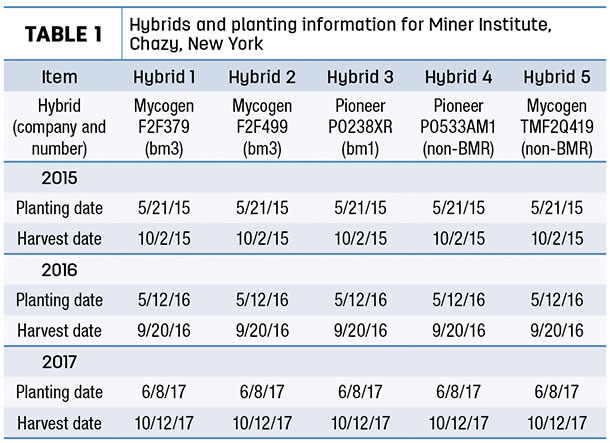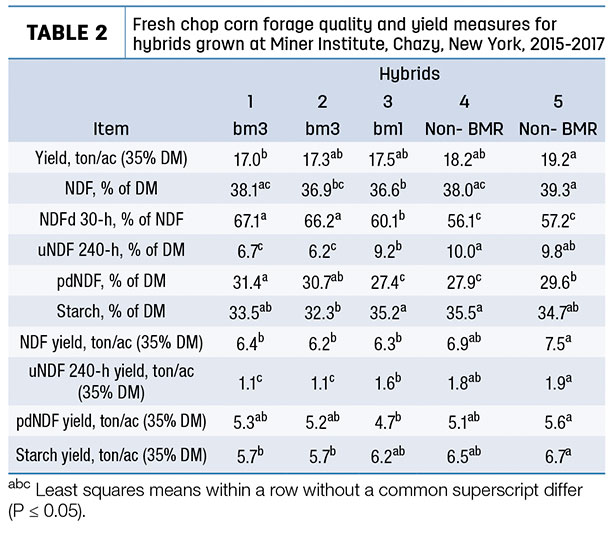Some of the metrics commonly used to evaluate varieties are yields (expressed as tons per acre), starch content, starch digestibility, neutral detergent fiber (NDF) content, and NDF digestibility (NDFd) at 30 hours. These are important because corn silage provides energy to the cow from fiber and starch. In the last few years, NDF has been more well defined using in vitro fermentation at multiple times points – usually 30, 120 and 240 hours – and are called undigested NDF (uNDF).
Undigested NDF at 240 hours (uNDF at 240-h) is the measure of the indigestible portion of the fiber and has been related to gut fill. With uNDF at 240-h and NDF, we then can calculate the potentially digestible NDF (pdNDF) by subtracting uNDF at 240-h from NDF. Better differentiation of fiber has given enhanced understanding of how the cow is able to utilize it. So in order to compare corn silage hybrids, these measures should be included.
High-quality forage starts with the seed choice, which makes corn silage hybrid selection vital to meeting the production goals of the farm. Using data from the hybrids grown on your farm and local hybrid trials can help make this decision. BMR corn silage has a mutation (bm1 or bm3) that produces less lignin and has increased NDFd. This allows for greater intakes but has been slow for widespread adoption due to cost of seed and lower yields.
A corn silage hybrid trial conducted at Miner Institute for three years (2015-17) compared BMR-3 (bm3), bm1 and non-BMR hybrids. The hybrid and planting information is presented in Table 1, and fresh-chop corn forage quality and yield measures are presented in Table 2. The non-BMR (hybrid 5) had a higher yield than the bm3 (hybrid 1). This was not a surprise, but the other bm3 and bm1 (hybrids 2 and 3) were not different from non-BMR hybrids (hybrid 4 and 5), which was a surprise. BMR-3 hybrids (hybrid 1 and 2) had higher NDFd at 30-h than bm1 and non-BMR hybrids (hybrids 3, 4 and 5), and the bm1 (hybrid 3) had a higher NDFd at 30-h than the non-BMR hybrids (hybrids 4 and 5). BMR-3 hybrids (hybrid 1 and 2) had lower uNDF at 240-h than bm1 and non-BMR hybrids (hybrids 3, 4 and 5).


Potentially digestible NDF (pdNDF) content was higher for the bm3 hybrid (hybrid 1) than bm1 and non-BMR hybrids (hybrids 3, 4 and 5), and bm3 (hybrid 2) and non-BMR (hybrid 5) hybrids had higher pdNDF than bm1 and non-BMR hybrids (hybrids 3 and 4). BMR-1 and non-BMR hybrids (hybrids 3 and 4) had higher starch content than the bm3 hybrid (hybrid 2). Based on the quality measures, the bm3 hybrids have higher NDFd at 30-h with lower uNDF at 240-h than the other hybrids.
Going one step further by calculating fiber and starch yields will allow better differentiation of corn silage hybrids. The fiber and starch yields are calculated by multiplying the yield by the nutrient fraction (NDF, uNDF at 240-h, pdNDF and starch) and presented on a 35 percent dry matter basis.
Non-BMR hybrid (hybrid 5) had higher NDF yield than bm3 and bm1 hybrids (hybrids 1, 2 and 3). The bm3 hybrids (hybrids 1 and 2) had lower uNDF at 240-h yield than bm1 and non-BMR hybrids (hybrids 3, 4 and 5), and the bm1 hybrid had a lower uNDF at 240-h yield than non-BMR hybrid (hybrid 5). The pdNDF yield was higher for non-BMR hybrid (hybrid 5) than the bm1 hybrid (hybrid 3). The starch yield was higher for non-BMR hybrid (hybrid 5) than the bm3 hybrids (hybrids 1 and 2). Based on the yield measures, the bm3 hybrids provided similar pdNDF yields as the other hybrids by having less indigestible fiber. Using quality and yield measures will help when making corn silage hybrid selection.
Miner Institute has created a spreadsheet to help with calculating fiber and starch yields. It is available online under “Dairy Management Tools” and called “Corn Silage Hybrid Fiber and Starch Yield Calculator.” There are three sheets: one for instructions called “Instructions”; the second one is to insert data called “Insert data”; and the third sheet is for results called “Yields.”
To calculate the fiber and starch yields, insert the yield and forage analysis in the “Insert data” sheet, but make sure that the units are same as the column headings. Once the data is inserted, then go to the “Yields” sheet, where the fiber and starch yields are calculated. To sort hybrids based on one of the measures, use the little drop-down box next to the measure’s name. These instructions are also on the first sheet.
Corn silage is a major feed component in dairy cow diets. So making the best choice for which hybrids to plant is a big decision for a farm. Since corn silage provides energy to the cow from the fiber and starch fractions, these should be used in evaluating different hybrids. To better evaluate the hybrids, the quality measures should be on a yield basis, and these can be easily calculated using the “Corn Silage Hybrid Fiber and Starch Yield Calculator” located on the Miner Institute website. ![]()

-
Michael Miller
- Research Technician II, Ph.D. Student
- William H. Miner Agricultural Research Institute
- Email Michael Miller
PHOTO: Photo courtesy of Getty Images.








